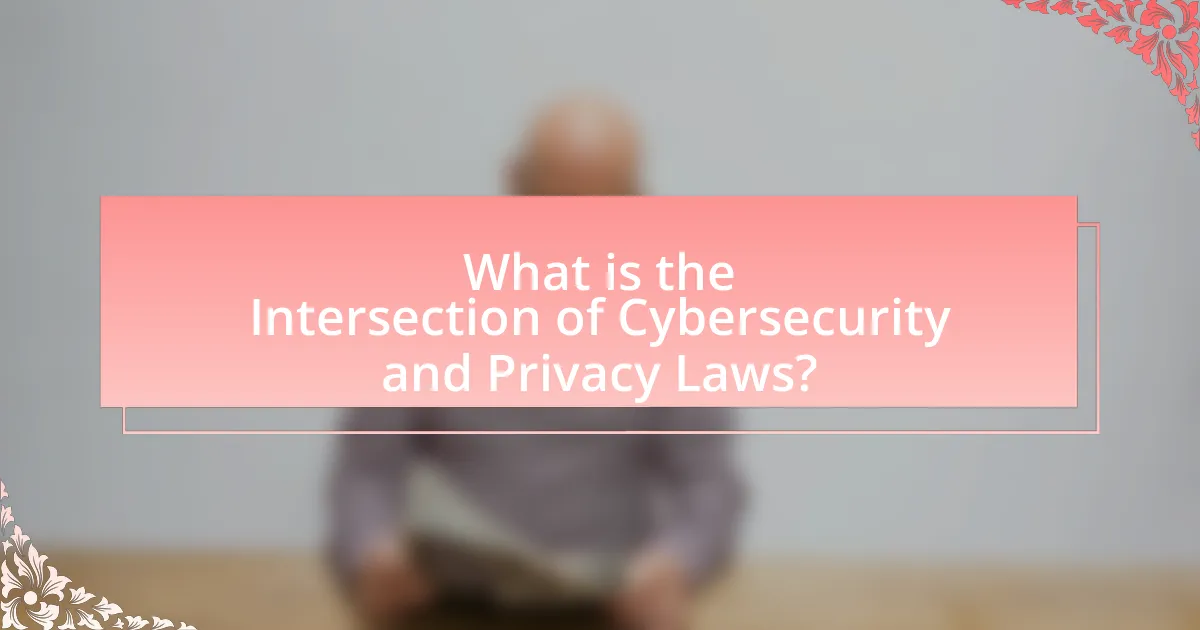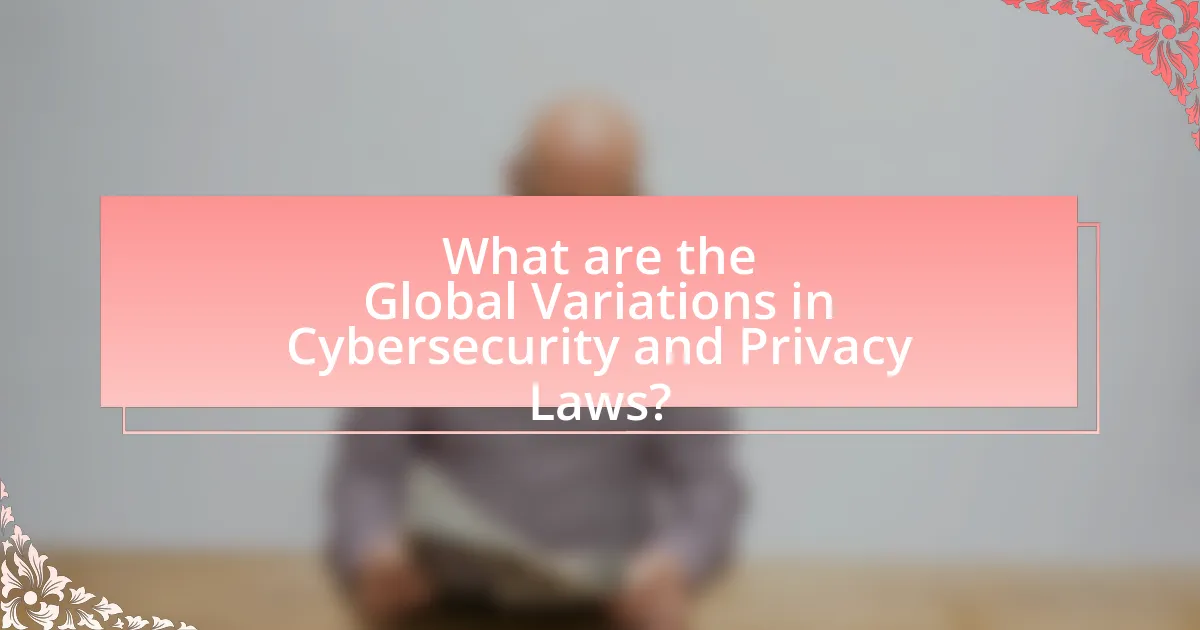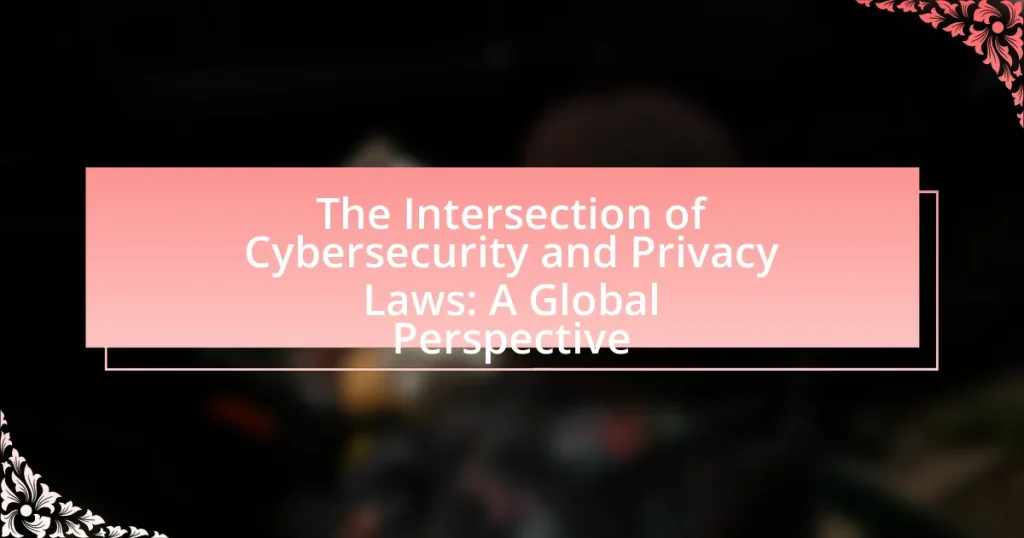The article examines the intersection of cybersecurity and privacy laws, highlighting the overlap between regulations that protect data from unauthorized access and those that safeguard personal information. It discusses the global interaction of these laws, emphasizing frameworks like the General Data Protection Regulation (GDPR) and their influence on international standards. Key principles of cybersecurity laws, fundamental aspects of privacy laws, and the significance of their intersection are analyzed, along with the challenges organizations face in compliance. The article also explores global variations in these laws, notable regulations in the United States and Europe, and best practices for aligning cybersecurity and privacy efforts to mitigate risks associated with data breaches.

What is the Intersection of Cybersecurity and Privacy Laws?
The intersection of cybersecurity and privacy laws involves the overlap between regulations designed to protect data from unauthorized access and those aimed at safeguarding individuals’ personal information. Cybersecurity laws focus on the technical measures and protocols organizations must implement to secure data, while privacy laws govern how personal data is collected, used, and shared. For instance, the General Data Protection Regulation (GDPR) in the European Union mandates strict data protection measures and grants individuals rights over their personal data, thereby influencing cybersecurity practices. This relationship highlights the necessity for organizations to integrate both legal frameworks to ensure comprehensive protection of sensitive information and compliance with regulatory requirements.
How do cybersecurity and privacy laws interact globally?
Cybersecurity and privacy laws interact globally through a complex framework of regulations that aim to protect data while ensuring security. Countries often align their laws to address cross-border data flows, with frameworks like the General Data Protection Regulation (GDPR) in the European Union influencing global standards. For instance, GDPR mandates strict data protection measures, which compel organizations worldwide to adopt similar practices to comply when handling EU citizens’ data. Additionally, international agreements, such as the Asia-Pacific Economic Cooperation (APEC) Privacy Framework, promote interoperability between different legal systems, facilitating cooperation in cybersecurity efforts. This interaction is essential for managing risks associated with cyber threats while respecting individual privacy rights, as evidenced by the increasing number of countries adopting comprehensive data protection laws inspired by GDPR.
What are the key principles of cybersecurity laws?
The key principles of cybersecurity laws include protection of data integrity, confidentiality, and availability. These principles ensure that sensitive information is safeguarded against unauthorized access, breaches, and cyber threats. For instance, the General Data Protection Regulation (GDPR) emphasizes data protection and privacy for individuals within the European Union, mandating organizations to implement appropriate security measures. Additionally, the principle of accountability requires organizations to demonstrate compliance with cybersecurity regulations, as seen in the Cybersecurity Information Sharing Act (CISA) in the United States, which encourages sharing of threat information while maintaining legal protections.
What are the fundamental aspects of privacy laws?
The fundamental aspects of privacy laws include the protection of personal data, the rights of individuals regarding their information, and the obligations of organizations to manage that data responsibly. Privacy laws, such as the General Data Protection Regulation (GDPR) in the European Union, establish clear guidelines on how personal data should be collected, processed, and stored, ensuring that individuals have control over their own information. These laws also mandate transparency from organizations, requiring them to inform individuals about data usage and to obtain consent before processing personal data. Furthermore, privacy laws often include provisions for data breach notifications, ensuring that individuals are informed if their data is compromised.
Why is the intersection of these laws significant?
The intersection of cybersecurity and privacy laws is significant because it addresses the dual need for protecting sensitive information while ensuring individual rights. This intersection is crucial as it helps organizations navigate compliance requirements, such as the General Data Protection Regulation (GDPR) in Europe, which mandates strict data protection measures alongside cybersecurity protocols. Furthermore, the convergence of these laws fosters a comprehensive approach to risk management, enabling businesses to mitigate threats effectively while respecting user privacy. This is evidenced by the increasing number of data breaches that highlight the necessity for robust cybersecurity measures that align with privacy regulations, demonstrating that effective governance in this area is essential for maintaining public trust and legal compliance.
How do these laws protect individuals and organizations?
Cybersecurity and privacy laws protect individuals and organizations by establishing legal frameworks that mandate the safeguarding of personal and sensitive information. These laws, such as the General Data Protection Regulation (GDPR) in Europe and the California Consumer Privacy Act (CCPA) in the United States, require organizations to implement security measures to prevent data breaches and unauthorized access. For instance, GDPR imposes strict penalties for non-compliance, which incentivizes organizations to prioritize data protection. Additionally, these laws empower individuals with rights over their personal data, such as the right to access, correct, and delete their information, thereby enhancing personal privacy and control.
What are the potential risks of non-compliance?
The potential risks of non-compliance with cybersecurity and privacy laws include significant financial penalties, legal repercussions, and reputational damage. Organizations may face fines that can reach millions of dollars, as seen in cases like the GDPR violations where companies were fined up to 4% of their annual global turnover. Additionally, non-compliance can lead to lawsuits from affected individuals or entities, further escalating legal costs. Reputational damage can result in loss of customer trust and market share, as consumers increasingly prioritize data protection. For instance, a study by IBM found that 77% of consumers would stop purchasing from a company that experienced a data breach.

What are the Global Variations in Cybersecurity and Privacy Laws?
Global variations in cybersecurity and privacy laws are significant, reflecting diverse legal frameworks and cultural attitudes towards data protection. For instance, the European Union’s General Data Protection Regulation (GDPR) sets a high standard for privacy rights, emphasizing user consent and data protection, while the United States employs a sectoral approach, with laws like the Health Insurance Portability and Accountability Act (HIPAA) for healthcare data and the California Consumer Privacy Act (CCPA) for consumer data. In contrast, countries like China enforce strict cybersecurity laws that prioritize state control over data, as seen in the Cybersecurity Law of 2017, which mandates data localization and government access to data. These differences illustrate how legal, cultural, and economic factors shape the regulatory landscape for cybersecurity and privacy globally.
How do different countries approach cybersecurity regulations?
Different countries approach cybersecurity regulations through varying frameworks and levels of enforcement. For instance, the European Union implements the General Data Protection Regulation (GDPR), which mandates strict data protection and privacy measures, influencing member states to adopt comprehensive cybersecurity laws. In contrast, the United States employs a more fragmented approach, with sector-specific regulations like the Health Insurance Portability and Accountability Act (HIPAA) for healthcare and the Federal Information Security Management Act (FISMA) for federal agencies, leading to inconsistencies across states. Additionally, countries like China enforce stringent cybersecurity laws that emphasize state control and data localization, reflecting their unique political and social context. These diverse regulatory approaches highlight the global disparity in prioritizing cybersecurity and privacy, shaped by each country’s legal, cultural, and economic factors.
What are the notable cybersecurity laws in the United States?
Notable cybersecurity laws in the United States include the Cybersecurity Information Sharing Act (CISA) of 2015, the Health Insurance Portability and Accountability Act (HIPAA), and the Federal Information Security Modernization Act (FISMA). CISA facilitates the sharing of cybersecurity threat information between the government and private sector to enhance national security. HIPAA establishes standards for protecting sensitive patient health information, mandating safeguards against data breaches. FISMA requires federal agencies to secure their information systems, ensuring they implement risk management practices and report on their cybersecurity posture. These laws collectively aim to strengthen the cybersecurity framework across various sectors in the U.S.
How do European Union regulations differ from those in other regions?
European Union regulations, particularly the General Data Protection Regulation (GDPR), differ significantly from those in other regions by emphasizing strict data protection and privacy rights for individuals. The GDPR mandates that organizations must obtain explicit consent from users before processing their personal data, imposes heavy fines for non-compliance, and grants individuals rights such as data access and the right to be forgotten. In contrast, many regions, such as the United States, adopt a more sectoral approach to data privacy, lacking comprehensive federal regulations and often prioritizing business interests over individual privacy rights. This difference is evident in the U.S. where laws like the California Consumer Privacy Act (CCPA) provide some protections but do not match the breadth and rigor of the GDPR.
What privacy laws are prominent in various jurisdictions?
Prominent privacy laws in various jurisdictions include the General Data Protection Regulation (GDPR) in the European Union, the California Consumer Privacy Act (CCPA) in California, the Personal Information Protection and Electronic Documents Act (PIPEDA) in Canada, and the Lei Geral de Proteção de Dados (LGPD) in Brazil. The GDPR, enacted in 2018, sets a high standard for data protection and privacy across EU member states, emphasizing user consent and data subject rights. The CCPA, effective from 2020, grants California residents specific rights regarding their personal information, including the right to know what data is collected and the right to opt-out of its sale. PIPEDA, which governs private-sector data handling in Canada, requires organizations to obtain consent for data collection and use. The LGPD, implemented in 2020, mirrors many aspects of the GDPR, focusing on the protection of personal data and the rights of individuals in Brazil. These laws reflect a growing global emphasis on data privacy and protection, driven by increasing public awareness and regulatory scrutiny.
What is the General Data Protection Regulation (GDPR) and its impact?
The General Data Protection Regulation (GDPR) is a comprehensive data protection law enacted by the European Union in May 2018, aimed at enhancing individuals’ control over their personal data. The GDPR impacts organizations by imposing strict requirements for data handling, including obtaining explicit consent from individuals, ensuring data portability, and mandating the reporting of data breaches within 72 hours. Non-compliance can result in significant fines, up to 4% of annual global turnover or €20 million, whichever is higher. This regulation has set a global standard for data privacy, influencing legislation in other jurisdictions and prompting organizations worldwide to adopt more stringent data protection measures.
How do privacy laws in Asia compare to those in the West?
Privacy laws in Asia generally emphasize state control and data localization, while those in the West prioritize individual rights and data protection. For instance, countries like China enforce strict regulations under the Personal Information Protection Law (PIPL), which mandates that data must be stored within its borders and grants the government extensive surveillance powers. In contrast, the European Union’s General Data Protection Regulation (GDPR) focuses on user consent and the right to data portability, reflecting a more individual-centric approach. This divergence highlights the contrasting philosophies: Asia often prioritizes national security and economic interests, whereas Western laws tend to emphasize personal privacy and autonomy.

What Challenges Arise at the Intersection of Cybersecurity and Privacy Laws?
Challenges at the intersection of cybersecurity and privacy laws include conflicting regulatory requirements, the complexity of compliance, and the evolving nature of threats. Organizations often face difficulties in aligning their cybersecurity measures with privacy regulations, such as the General Data Protection Regulation (GDPR) in Europe, which mandates strict data handling practices while also requiring robust security measures. For instance, GDPR emphasizes data minimization and user consent, which can conflict with cybersecurity practices that necessitate broader data collection for threat detection. Additionally, the rapid pace of technological advancement complicates compliance, as laws may lag behind emerging threats and new technologies. This creates a landscape where organizations struggle to meet both cybersecurity and privacy obligations simultaneously, leading to potential legal liabilities and reputational risks.
What are the common compliance challenges faced by organizations?
Organizations commonly face challenges such as keeping up with evolving regulations, managing data privacy, and ensuring employee training on compliance. The rapid pace of regulatory changes, particularly in cybersecurity and privacy laws, creates difficulties in maintaining compliance. For instance, the General Data Protection Regulation (GDPR) has imposed strict requirements on data handling, leading to confusion and potential non-compliance among organizations. Additionally, organizations struggle with integrating compliance measures into existing processes, which can result in gaps in data protection. A survey by PwC found that 61% of organizations reported difficulties in understanding and implementing compliance requirements, highlighting the widespread nature of these challenges.
How can organizations navigate conflicting regulations?
Organizations can navigate conflicting regulations by implementing a comprehensive compliance strategy that includes legal consultation, risk assessment, and prioritization of regulatory requirements. This approach allows organizations to identify which regulations are most applicable to their operations and to develop policies that align with both cybersecurity and privacy laws. For instance, a company operating in multiple jurisdictions may need to harmonize its data protection practices to comply with the General Data Protection Regulation (GDPR) in Europe while also adhering to the California Consumer Privacy Act (CCPA) in the United States. By conducting regular audits and engaging with legal experts, organizations can ensure they remain compliant and mitigate the risk of penalties associated with conflicting regulations.
What role does technology play in compliance efforts?
Technology plays a crucial role in compliance efforts by automating processes, enhancing data management, and ensuring adherence to regulations. Automation tools streamline compliance tasks, reducing human error and increasing efficiency, while advanced data analytics enable organizations to monitor compliance in real-time. For instance, regulatory technology (RegTech) solutions help businesses comply with laws such as the General Data Protection Regulation (GDPR) by providing tools for data protection assessments and reporting. According to a report by Deloitte, 70% of organizations using technology for compliance reported improved accuracy and reduced costs associated with compliance activities.
How do breaches in cybersecurity affect privacy laws?
Breaches in cybersecurity significantly impact privacy laws by prompting legislative changes and stricter enforcement measures. When a data breach occurs, it often exposes personal information, leading to increased public concern and demands for stronger protections. For instance, the General Data Protection Regulation (GDPR) in the European Union was enacted partly in response to high-profile breaches, establishing stringent requirements for data protection and imposing heavy fines for non-compliance. Additionally, breaches can lead to amendments in existing laws, as seen in various U.S. states that have updated their data breach notification laws to enhance transparency and accountability. These developments illustrate how cybersecurity incidents directly influence the evolution and enforcement of privacy regulations globally.
What are the legal implications of data breaches?
Data breaches can lead to significant legal implications, including regulatory penalties, civil liability, and reputational damage. Organizations that experience data breaches may face fines from regulatory bodies, such as the General Data Protection Regulation (GDPR) in the European Union, which can impose penalties of up to 4% of annual global revenue or €20 million, whichever is greater. Additionally, affected individuals may file lawsuits for damages, resulting in civil liability for the organization. For instance, in the case of the Equifax breach in 2017, the company faced a settlement of $700 million due to legal claims from affected consumers and regulatory actions. These legal consequences underscore the importance of robust cybersecurity measures and compliance with privacy laws to mitigate risks associated with data breaches.
How can organizations mitigate risks associated with breaches?
Organizations can mitigate risks associated with breaches by implementing comprehensive cybersecurity strategies that include regular security assessments, employee training, and robust incident response plans. Regular security assessments help identify vulnerabilities, allowing organizations to address weaknesses before they can be exploited. Employee training ensures that staff are aware of potential threats and best practices for data protection, reducing the likelihood of human error leading to breaches. Additionally, having a well-defined incident response plan enables organizations to respond swiftly and effectively to breaches, minimizing damage and recovery time. According to the Ponemon Institute’s 2021 Cost of a Data Breach Report, organizations with an incident response team and tested incident response plans can reduce the average cost of a data breach by $2 million.
What Best Practices Should Organizations Follow to Align Cybersecurity and Privacy Laws?
Organizations should implement a comprehensive risk assessment framework to align cybersecurity and privacy laws effectively. This involves regularly evaluating their data handling practices, identifying vulnerabilities, and ensuring compliance with relevant regulations such as the General Data Protection Regulation (GDPR) and the Health Insurance Portability and Accountability Act (HIPAA). By conducting these assessments, organizations can establish a clear understanding of their legal obligations and the potential risks associated with data breaches.
Additionally, organizations should develop and maintain a robust data governance policy that includes employee training on privacy and cybersecurity best practices. This policy should outline procedures for data collection, storage, and sharing, ensuring that all employees are aware of their responsibilities in protecting sensitive information. Research indicates that organizations with comprehensive training programs experience 70% fewer security incidents, highlighting the importance of employee awareness in compliance efforts.
Furthermore, organizations should adopt a proactive approach by integrating privacy by design into their systems and processes. This means considering privacy implications during the development phase of new projects and technologies, thereby minimizing risks from the outset. The International Association of Privacy Professionals (IAPP) emphasizes that embedding privacy into the design process can lead to better compliance outcomes and reduced legal liabilities.
In summary, organizations can align cybersecurity and privacy laws by conducting risk assessments, implementing data governance policies, providing employee training, and integrating privacy by design into their operations.
How can organizations develop a comprehensive compliance strategy?
Organizations can develop a comprehensive compliance strategy by conducting a thorough risk assessment to identify regulatory requirements and potential vulnerabilities. This involves mapping out applicable laws, such as GDPR or HIPAA, and understanding their implications on business operations. Additionally, organizations should implement robust policies and procedures that align with these regulations, ensuring that all employees are trained on compliance protocols. Regular audits and assessments are essential to evaluate the effectiveness of the compliance strategy and to make necessary adjustments. According to a 2021 study by the Ponemon Institute, organizations with a formal compliance program experience 50% fewer data breaches, highlighting the importance of a structured approach to compliance.
What tools and resources are available for effective compliance management?
Effective compliance management can be achieved through various tools and resources, including compliance management software, regulatory databases, and training programs. Compliance management software, such as LogicGate and ComplyAdvantage, helps organizations automate compliance processes and track regulatory changes. Regulatory databases, like LexisNexis and Westlaw, provide access to up-to-date legal information and compliance requirements across jurisdictions. Additionally, training programs and workshops, often offered by organizations like the International Association of Privacy Professionals (IAPP), equip employees with the necessary knowledge to adhere to compliance standards. These resources collectively enhance an organization’s ability to manage compliance effectively in the context of cybersecurity and privacy laws.


